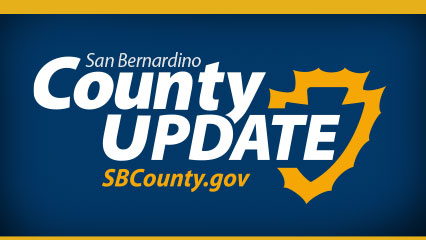
• News Now – April edition
• County positioned to address expected increase in homelessness
• Be a part of the largest hiring event in the High Desert!
• Residents impacted by storms eligible for special CalFresh benefits – Apply by May 9
• FEMA opening a Disaster Recovery Center in Twin Peaks
• Animal Care launches “National Adopt a Shelter Pet Day” adoption event
• Calling all stargazers! Museum Cosmic Nights returns
• Weekend Westbound SR 210 construction canceled
• Pet of the Week: Riley
San Bernardino County News Now
In this episode of San Bernardino County News Now learn how county building inspectors are ensuring structures are safe to re-open after heavy snow compromised the integrity of several homes and businesses in mountain communities. Plus, Smile SBC and First 5 San Bernardino are teaming up to teach kids about the big responsibility of keeping little teeth healthy. And, San Bernardino County’s Second District Supervisor Jesse Armendarez has the floor in this month’s District Minute.
County positioned to address expected increase in homelessness

The decision by the Board of Supervisors last month to leverage $72.7 million in federal, state and county resources to support its landmark 2022 Homeless Strategic Action Plan positions the County well to address its share of a regional growth in homelessness appearing in the results of homeless counts in many jurisdictions.
Be a part of the largest hiring event in the High Desert!

Largest hiring event at Victor Valley College, in partnership with San Bernardino County Workforce Development, the Greater High Desert Chamber of Commerce, Goodwill of Southern California and El Dorado Broadcasters!
Residents impacted by storms eligible for special CalFresh benefits – Apply by May 9

Did you live or work in an area impacted by the recent Winter Storms between Feb. 21 and March 22, 2023? Were you unable to work or get paid? Was your home or workplace damaged? Did you incur disaster-related costs, including food, shelter, or evacuation? You may be eligible! Disaster CalFresh provides one month of food benefits to eligible disaster-impacted households that do not already receive CalFresh benefits. Households may be eligible to a 30-day non-prorated payment. For example, a family of four with a monthly income up to $3,130 per month may be eligible to receive up to $939 in food benefits through this program. Apply online at BenefitsCal.com between April 29 and May 9 or visit your local Transitional Assistance Department (TAD) office. You may also call 1-877-410-8829 to see if you qualify.
FEMA opening a Disaster Recovery Center in Twin Peaks

For mountain residents and businesses impacted by the winter storms and seeking help, the Federal Emergency Management Agency (FEMA) and the U.S. Small Business Administration (SBA) have opened a Disaster Resource Center (DRC) in Twin Peaks.
Animal Care launches “National Adopt a Shelter Pet Day” adoption event

Are you looking to add a furry friend to your family? Look no further than Animal Care’s “National Adopt a Shelter Pet Day” event, running from April 29 to May 7 at the Big Bear and Devore Animal Shelters. Dogs are $25 and cats are $17. All pets come spayed/neutered, microchipped, and receive most vaccines.
Calling all stargazers! Museum Cosmic Nights returns

Whether you have yet to experience the grandeur of Jupiter, Saturn, or the waxing gibbous moon, or you are a dedicated amateur astronomer, Cosmic Nights offers unparalleled views of the celestial wonders. Come join us for this popular family-friendly event. General admission is $10 (adult), $8 (military or senior), $7 (student), and $5 (child ages 6 to 12). Children under five and Museum Association members are free.
Weekend Westbound SR 210 construction canceled

This weekend’s directional 55-hour closure of westbound SR 210 between the I-10 connectors and 5th Street/Greenspot Road has been canceled. Closures are anticipated to resume the weekend of May 5. The 55-hour directional closure is scheduled for Friday, May 5 at 10 p.m. to Monday, May 8, at 5 a.m.
Pet of the Week: Riley
This week’s Pet of the Week is Riley (ID # A776652). Riley is a spayed female who looks like a Husky and Shepherd mix. She’s estimated to be 4 months old. Riley was found near Highland and has been at the Devore Animal Shelter since April 21, 2023.
For information about animals available for adoption in San Bernardino County’s Big Bear and #Devore shelters, please visit San Bernardino County Animal Care at animalcare.sbcounty.gov/pets to see photographs of the pets awaiting adoption or call (800) 472-5609.
To donate to assist animals at the shelter, visit www.arffund.org.
Join our award-winning workforce at San Bernardino County

San Bernardino County has jobs that will open on Saturday, April 29.
We encourage you to apply and share these job openings with those who may be interested in them. Recruitments listed are subject to final department approval.
Check Job Opportunities for the most up-to-date recruitments.
